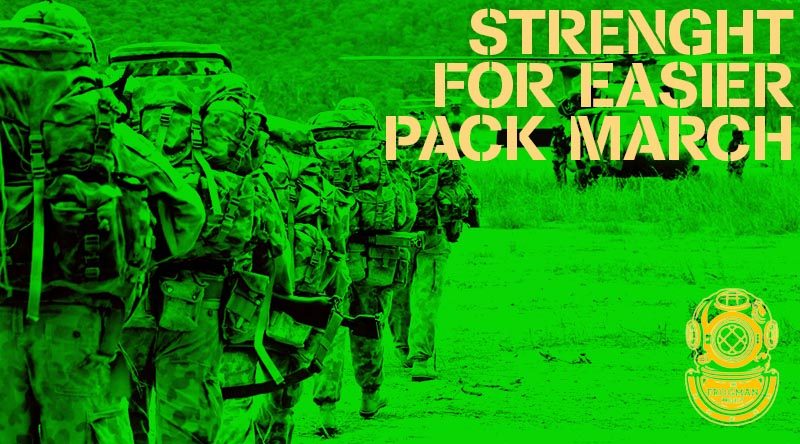Get stronger for easier pack marching

We have searched far and wide for info on how to improve your pack marching using strength and conditioning before you hit the terrain.
So here it is – what you should be doing to get stronger for easier pack marching.
.
For those of you new to the concept, pack marches are a common way in which a soldier moves X amount of his tools (his fighting tools, his living tools, his heart and mind tools –whatever tools he needs to survive in the field) from point A to point D, I, Z, H, K, E etc etc (and probably more likely in that order than A to B). Simple.
Issues arise for many when it comes to the weight of the pack and the terrain that is to be travelled x the time under tension.
>
How to improve?
Improving your pack marching is simply done by performing the exact thing you want to get better at – more of the same – pack marching.
You have to pack march to get better at pack marching.
The difference in improvement however can be dramatic when paired with the correct strength and mobility tools.
A lot of the time people tend to focus on leg press, squats and lunges for improving a ‘yomp’.
This has some merit, as knee extensors are loaded for sure – but not in isolation and, in fact, they are not (or rather should not) be the primary workers here.
The main muscles we should be looking to load are the glutes, hamstrings, calves, back and abdomen and the main tissues we want to prepare are connective tissues in the knees, ankles and spine.
As for corrective health – shoulders, thoracic spine and hips should all be focused on.
Below I’m going to give you an insight into how we program for our Tactical Fitness League. I’ll give you some exercises for all of these and a bit of an explanation as to why I choose these areas.
.
Strength:
- Upper back – we need a powerful upper shoulder carriage and mid upper trap area to maintain a strong support for the straps of the pack and to help stabilise the lumbar spine and cervical spine. A strong upper back will also help keep our chest from collapsing (restricting breathing) and from forcing our head down (if you can’t lift your head to see what’s around you, that’s bad, and cadre staff notice that). A great exercise for this would be the snatch high pull
- Lower back – this is crucial and often the weakest link for most people. A weak lower back means you have no major supporting strength where you need it the most. You are not going to be able to handle load through the spine well and are more likely to herniate your spine or abdomen with extreme load. Also, a weak low back makes your lumbar spine mobile – and losing stability here is very bad. One of my favourite ways to strengthen my lower back – and specifically for pack work and loaded athletes – Good Mornings (many variations but for this one we will use seated to begin with)
- Abs – a strong and stable core that can brace, relax, twist, extend and flex smoothly and strongly are key and a great little circuit for you guys to do 2-3 times per week at the end of a session is this (aim to squeeze the abs hard for all of these)…
A1 – Ab wheel roll out x 8-10 reps (if you feel this in your back or arms you are doing it wrong, brace the core hard and aiming to contract the abs immensely)
A2 – Hollow body dish hold x 60 sec
3 sets of A1, A2, resting 60 sec after A2 only.
B1 Weighted sit up x 6-8 reps
B2 Hanging leg lift or swedish bench lift x 6-8 reps
3 sets of B1, B2, resting 60 sec after B2 only.
C1 Standing cable crunch x 10-12 reps
C2 Standing cable side crunches x 10-12 reps each side
3 sets of C1, C2, resting 60 sec after C2 only.
- Glutes – if you get the glutes working well, most things will fix themselves in the back, hips and knees. An incredible way to build useable strength and switch on the glutes hard is Snatch grip deficit deadlifts
- Hamstrings – The hamstrings are powerful contractors and they have two main jobs. One – contract powerfully and explosively to provide hip extension and give you the ability to run fast, jump high and walk powerfully. The second is stabilisers – they are a main stabiliser of the knee and help to absorb a lot of force through the leg. They are one of the most overlooked athletic muscles that people need to switch on more. The most powerful exercise I’ve ever come across for doing just that is The Harrop curl
- Calves – Calf raises, single leg, double leg, weighted, toes in, toes out, donkey calf raises – lots of them – frequently. But, you must stretch them daily, at least three minutes a side (90 sec each calf passive stretch off a step for 3 sets each is great). As for strength range, 20 reps x 5 sets is brutal and will work great.
Stretches:
- Active pigeon
start with 10 reps and a 10 sec isometric hold on the last rep – avoid pain.
- Diagonal stretch
start with 10 reps and a 10 sec isometric hold on the last rep – avoid pain.
- Feet elevated back bridge
start with 30 sec holds – avoid pain.
2-3 sets of above exercises approached gently and listen to your body, 2-3 times per week.
Connective tissue:
For these connective tissue exercises, typically low intensity, higher reps, 10-20, and listen to the body, 2-3 sets, 1-2 times per week max is plenty 🙂 Avoid pan, only take to pressure.
.
.
This is my go to list for preparing stronger bodies to handle the rigours of pack marching.
You must become an ox. Big – Strong – Stable – Supple.
Sample Workout from the Tactical Fitness League
When you’re ready to practice your pack marching, here’s an example workout for all 3 levels from TFL.
Recruit
Perform 3km pack march with 10kg pack, aiming to complete this in under 30 minutes
+ 20 minutes of seated box breathing and meditation + 10 minute total time of passive hang from bar.
Graduate
Perform 4km pack march with 10kg pack, aiming to complete this in under 35 minutes
+ 20 minutes of seated box breathing and meditation + 10 minutes total time of passive hang from bar.
Operator
45 minute pack march with 15kg pack. Record distance and aim to get comfortable with this distance before pushing for a better time – we need to get your bones used to stress from frequency. A good distance would be up to 6km.
Cheers for now,
Coach Sean
.
.
.
.
.
.
.

.
.






